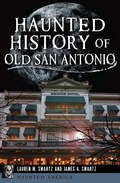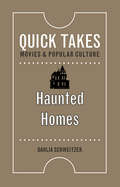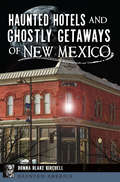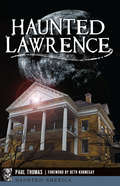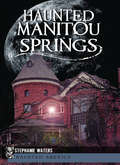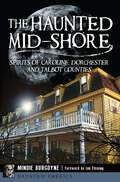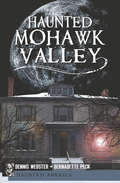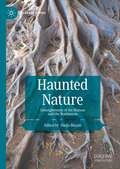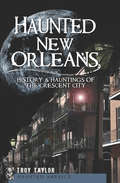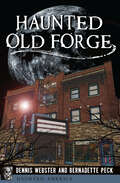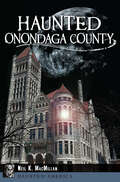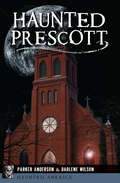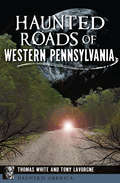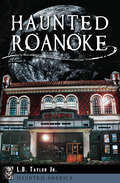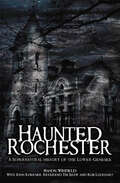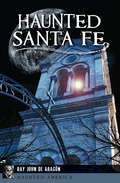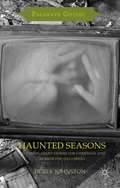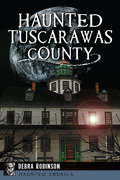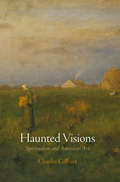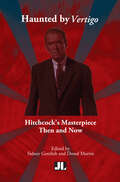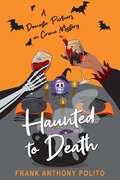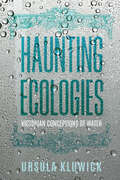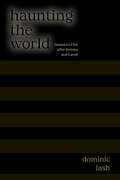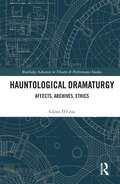- Table View
- List View
Haunted History of Old San Antonio (Haunted America)
by Lauren M. Swartz James A. SwartzEverything is bigger in Texas—including ghosts—especially in San Antonio, considered one of the ten most haunted cities in the world by National Geographic. As the saying goes, &“dead men tell no tales.&” Or do they? From its humble beginnings as a Spanish settlement in 1691 to the bloody battle at the Alamo, San Antonio&’s history is rich in haunting tales. Discover Old San Antonio&’s most haunted places and uncover the history that lies waiting for those who dare enter their doorways. Take a peek inside the Menger Hotel, the &“Most Haunted Hotel in Texas,&” and just a block away, peer into the Emily Morgan Hotel, renovated after a decade of being vacant, was once the city&’s first hospitals where many men and women lost their lives. Explore the San Fernando Cathedral, where people are buried within the walls and visitors claim to see faces mysteriously appear. Uncover the legends behind Bexar County Jail. Join authors James and Lauren Swartz and decide for yourself what truly lurks behind the Alamo City&’s fabled past. Includes photos!
Haunted Homes (Quick Takes: Movies and Popular Culture)
by Dahlia SchweitzerHaunted Homes is a short but groundbreaking study of homes in horror film and television. While haunted houses can be fun and thrilling, Hollywood horror tends to focus on haunted homes, places where the suburban American dream of safety and comfort has turned into a nightmare. From classic movies like The Old Dark House to contemporary works like Hereditary and the Netflix series The Haunting of Hill House, Dahlia Schweitzer explores why haunted homes have become a prime stage for dramatizing anxieties about family, gender, race, and economic collapse. She traces how the haunted home film was intertwined with the expansion of American suburbia, but also explores works like The Witch and The Babadook, which transport the genre to different times and places. This lively and readable study reveals how and why an increasing number of films imagine that home is where the horror is. Watch a video of the author discussing the topic Haunted Homes (https://youtu.be/_irTEfvtZfQ).
Haunted Hotels and Ghostly Getaways of New Mexico (Haunted America)
by Donna Blake BirchellTrue to its nickname, New Mexico enchants some souls so much they never leave. <P><P>The Express St. James of Cimarron plays host to the cantankerous spirit of former owner Thomas James "T.J." Wright. <P><P>At the Trinity Hotel in Carlsbad, Miss Ruby occasionally pranks unwitting guests and still cares for the rooms where she once worked. <P><P>The gentle ghost of Julie Staab sits weeping at the bar of La Posada when not running bath water in her former room. <P><P>And in death, Byron T. Mills looks over the Las Vegas Plaza Hotel he owned and neglected in life. <P><P>Local author Donna Blake Birchell shares the chilling stories of these permanent spectral guests.
Haunted Lawrence (Haunted America)
by Paul Thomas Beth KornegayFounded in 1854 as an abolitionist outpost, Lawrence is a seemingly unassuming college town with a long history of hauntings. A ghostly guest never checked out of the Eldridge Hotel�s mysterious room 506. Sigma Nu�s fraternity house, the former home of Kansas�s eighteenth governor, is still haunted by the specter of a young woman. Learn the tragic stories of Pete Vinegar, George Albach and Lizzie Madden and uncover the devilish truth behind the �legend� of Stull Cemetery. Author Paul Thomas reveals the ghoulish history behind these stories and many more.
Haunted Manitou Springs (Haunted America)
by Stephanie WatersDrink in the spooky spiritual history of this charming Rocky Mountain town—from the author of Colorado Legends & Lore. Manitou Springs has long been known as a spiritual hot spot. From the healing waters of the local springs to the town's patron spirit, the benevolent Emma Crawford, whose life and afterlife is celebrated annually at Halloween, Manitou Springs takes pride in its legends and legendary residents. Join haunted tour guide Stephanie Waters as she uncovers the stories behind some of Manitou&’s most famous ghostly tales: the historic spirit lights on Pikes Peak, the specters of Red Stone Castle where poor Emma&’s sister went mad and the phantoms of the stately Cliff House and Briarhurst Manor. Includes photos! &“Stephanie Waters, author of Haunted Manitou Springs, theorizes that the greenstone rock, which is plentiful at Red Crags, attracts extra energy in a town that&’s already no stranger to the mystical. The word Manitou even means spirit.&” —Manitou Marquee
Haunted Mid-Shore, The: Spirits of Caroline, Dorchester and Talbot Counties (Haunted America)
by Ian Fleming Mindie BurgoyneThere is an otherworldly quality to the Mid-Shore--ghosts seem to rise up from the Chesapeake, and quaint towns hold the spirits of their historic pasts. Oxford's Robert Morris Inn is still home to its colonial namesake, while the Kemp House in St. Michael's is host to the restless specter of Robert E. Lee. Murdered actress Marguerite rides the elevator of the Avalon Theater, and Wish Sheppard stalks the halls of the Denton Jail. Near the witching hour, the eerie sound of the swinging body of "Bloody" Henny Insley can be heard on the grounds of the Dorchester Courthouse. Author and ghost tour guide Mindie Burgoyne takes a chilling journey into the supernatural lore of Maryland's Mid-Shore.
Haunted Mohawk Valley: Mohawk Valley Ghosts And Other Historic Haunts (Haunted America)
by Dennis Webster Bernadette PeckHead toward central and upstate New York and discover this region&’s ghostly history . . . photos included! The Mohawk River winds through upstate and central New York, and along its meandering path residents and visitors have encountered the supernatural. In Utica, ghosts grace the stage of the Stanley Theater. Spirits of Revolutionary War soldiers still march on the Oriskany Battlefield and linger in Schoharie&’s Old Stone Fort. And some former residents of Beardslee Castle in St. Johnsville, Boonville&’s Hulbert House, and the Seashell Inn of Sylvan Beach have resisted vacating. Here, authors Dennis Webster and Bernadette Peck, along with the other members of Ghost Seekers of Central New York, uncover the mysteries behind these and many other haunted places of the Mohawk Valley.
Haunted Nature: Entanglements of the Human and the Nonhuman (Palgrave Gothic)
by Sladja BlazanThis volume is a study of human entanglements with Nature as seen through the mode of haunting. As an interruption of the present by the past, haunting can express contemporary anxieties concerning our involvement in the transformation of natural environments and their ecosystems, and our complicity in their collapse. It can also express a much-needed sense of continuity and relationality. The complexity of the question—who and what gets to be called human with respect to the nonhuman—is reflected in these collected chapters, which, in their analysis of cinematic and literary representations of sentient Nature within the traditional gothic trope of haunting, bring together history, race, postcolonialism, and feminism with ecocriticism and media studies. Given the growing demand for narratives expressing our troubled relationship with Nature, it is imperative to analyze this contested ground.
Haunted New Orleans: History & Hauntings of the Crescent City (Haunted America)
by Troy TaylorTravel beyond Bourbon Street into the macabre history of one of the most haunted cities in the United States with the author of Wicked New Orleans as your guide. New Orleans—the Big Easy, the birthplace of jazz, home of Cafe du Monde and what some call the most haunted city in America. Beneath the indulgence and revelry of the Crescent City lies a long history of the dark and mysterious. From the famous &“Queen of Voodoo,&” Marie Laveau, who is said to haunt the site of her grave, to the wicked LaLauries, whose true natures were hidden behind elegance and the trappings of high society, New Orleans is filled with spirits of all kinds. Some of the ghosts in these stories have sordid and scandalous histories, while others are friendly specters who simply can&’t leave their beloved city behind. Join supernatural historian Troy Taylor as he takes readers beyond the French Quarter and shows a side of New Orleans never seen. Includes photos!
Haunted Old Forge (Haunted America)
by Dennis Webster Bernadette PeckDiscover the paranormal past of this little town in the Adirondacks . . . photos included! Spirits linger on the pine-covered slopes of the Adirondack Mountains that surround Old Forge. Books fly off the shelves at the Maxson House, and something—or someone—spies on the living from the attic window of the Goodsell Museum. The spirit of Mohawk Peter Waters is said to linger along the shores of First Lake, where an assassin killed him in 1833. The scent of a phantom cigar hints at the presence of the former owner of the Strand Theatre. In this book, Dennis Webster and Bernadette Peck and the Ghost Seekers of Central New York take a chilling journey into the paranormal history of what may be the most haunted town in the nation.
Haunted Onondaga County (Haunted America)
by Neil MacmillanFrom the halls of Syracuse University to the quiet neighborhoods of Fayetteville and Marcellus, the communities of Onondaga County have a haunted history. Some sites are hotbeds of paranormal activity, like Syracuse's Woodlawn Cemetery, the Jamesville Penitentiary and Split Rock Quarry, where a blast killed several workers. Visitors at the Clay Hotel debate whose ghost walks the halls of the former German beer house and restaurant. Patrons of the Ancestor's Inn in Liverpool have also encountered unregistered and unwelcome guests. After Albert Fyler murdered his wife in a jealous rage, their spirits refused to leave the home they shared. Even the iconic Syracuse City Hall cannot rid itself of the otherworldly. Local author Neil K. MacMillan delves into this eerie past to uncover Onondaga County's most haunted locations.
Haunted Prescott (Haunted America)
by Parker Anderson Darlene WilsonWhen Arizona was created as a U.S. territory in 1864, Prescott became its first capital. Accompanying the city's rich history is an equally dramatic heritage of supernatural manifestations. Visitors report a strange chill in the Palace Restaurant and taps on the shoulder at the Smoki Museum. Lingering spirits crowd famed hotels like the Vendome and the Hassayampa Inn, as well as theaters such as the Elks Opera House and Prescott Center for the Arts. Learn the secrets of Prescott's cemeteries and the truth about the hangings on the Courthouse Plaza as Darlene Wilson and Parker Anderson lead an excursion through the haunted sites of Arizona's mile-high city.
Haunted Roads of Western Pennsylvania (Haunted America)
by Thomas White Tony LavorgneThe twisty roads—and twisted tales—of the Appalachian Mountains make for distracted driving in western Pennsylvania. Ghostly travelers are said to wander the lonely roads of western Pennsylvania. A creeping fog rises from Blue Mist Road, and stories of car crashes, lynchings and even strange beasts haunt this isolated stretch outside Pittsburgh. Is it the angry spirit of a jealous husband or a gypsy king who stalks Erie County&’s Axe Murder Hollow? Shades of Death Road in Washington County may be host to phantom coal miners killed during a deadly labor dispute. With firsthand accounts and historical research, authors Thomas White and Tony Lavorgne travel the backcountry roads and byways of western Pennsylvania to discover their ghost tales and mysterious legends. Includes photos! &“The authors include a history of each road along with the supernatural legends and other unexplained activity. Surprisingly, they are able to provide possible explanations for most of the alleged hauntings, but admit that they cannot account for every one, which allows the roads in question to keep their allure and spooky possibilities.&” —PopCultureGuy
Haunted Roanoke (Haunted America)
by L.B. Taylor Jr.The author of The Big Book of Virginia Ghost Stories focuses on the &“Scare City&”: &“If you believe in ghosts, this is the book for you&” (The Roanoke Times). Roanoke, in the heart of southwestern Virginia, is one of the most haunted cities in the commonwealth. The Star City is brimming with eerie and unexplainable stories, such as the legendary &“Woman in Black,&” who appeared several times in 1902, but only to married men on their way home at night. There are also macabre stories in many of Roanoke&’s famous landmarks, such as the majestic Grandin Theatre, where a homeless family is said to have lived—and the cries of their deceased children can still be heard. Travel beyond the realm of reality with author L.B. Taylor Jr. as he traces the history of Roanoke&’s most unique and chilling tales. Includes photos! &“I like the ghost story books of L.B. Taylor, Jr., a Virginia author, because he blends history and true ghost stories so wonderfully. He doesn&’t make judgments about each ghost story, but presents the facts and lets you decide for yourself. . . . So if you&’re in a ghostly mood this October—or if you&’re just a history lover—Taylor&’s books are well worth your time.&” —Eagle-Eyed Editor
Haunted Rochester: A Supernatural History of the Lower Genesee (Haunted America Ser.)
by Mason Winfield Rob Lockhart John Koerner Reverend Tim ShawThe western New York state Great Lakes region serves as a scenic setting for supernatural traditions, incidences, and folklore. Avenging specters, demon-tortured roads, holy miracles, weird psychic events, prehistoric power sites, ancient curses, Native American shamans, active battlefields, ghost ships, black dogs, haunted monuments, and the phantoms of Rochester&’s famous—all are part of the legacy of Rochester and the lower Genesee. Supernatural historian Mason Winfield and the research team from Haunted History Ghost Walks, Inc., take us on a spiritual safari through the Seneca homeland of the &“Sweet River Valley&” and the modern city in its place. After their survey of Rochester&’s super natural history and tradition, &“the Flour City&” will never look the same. Includes photos!
Haunted Seasons: Television Ghost Stories for Christmas and Horror for Halloween (Palgrave Gothic)
by Derek JohnstonThis book explores the literary and cultural history behind certain Christmas and Halloween traditions, and examines the way that they have moved into broadcasting. It demonstrates how these horror traditions have become more domestic and personal, and how they provide a necessary seasonal pause for reflection on our fears.
Haunted Tuscarawas County (Haunted America)
by Debra RobinsonTuscarawas County's history stretches back to the pioneer era. Some history, however, refuses to remain in the past. Towns and sites founded in the 1700s and 1800s, like Zoar, Schoenbrunn and Dennison Depot, abound with legends and spectral encounters. Helpful haunts reside at the Little Theatre and Dover Public Library. The sad specter of poor axe-murdered Mary Seneff rises from the Red Hill bridge over little Sugarcreek. And Newcomerstown's young post boy, William Cartmill, still tries to deliver his mail. Author Debra Robinson delves into the area's ghost tales and the history behind them.
Haunted Visions
by Charles ColbertSpiritualism emerged in western New York in 1848 and soon achieved a wide following due to its claim that the living could commune with the dead. In Haunted Visions: Spiritualism and American Art, Charles Colbert focuses on the ways Spiritualism imbued the making and viewing of art with religious meaning and, in doing so, draws fascinating connections between art and faith in the Victorian age.Examining the work of such well-known American artists as James Abbott McNeill Whistler, William Sydney Mount, and Robert Henri, Colbert demonstrates that Spiritualism played a critical role in the evolution of modern attitudes toward creativity. He argues that Spiritualism made a singular contribution to the sanctification of art that occurred in the latter half of the nineteenth century. The faith maintained that spiritual energies could reside in objects, and thus works of art could be appreciated not only for what they illustrated but also as vessels of the psychic vibrations their creators impressed into them. Such beliefs sanctified both the making and collecting of art in an era when Darwinism and Positivism were increasingly disenchanting the world and the efforts to represent it. In this context, Spiritualism endowed the artist's profession with the prestige of a religious calling; in doing so, it sought not to replace religion with art, but to make art a site where religion happened.
Haunted by Vertigo: Hitchcock's Masterpiece Then and Now
by Sidney Gottlieb and Donal MartinWhen Richard Schickel stated unequivocally in 1972 that "We're living in a Hitchcock world, all right", he did so without even mentioning the film that now stands at the top of the Sight & Sound Greatest Films of All Time poll: Vertigo. That omission needs to be redressed when we think about the Hitchcock world we live in now. Haunted by Vertigo: Hitchcock's Masterpiece Then and Now gathers essays that offer a variety of approaches to what many consider to be Hitchcock's signature film, one that shows him operating at full strength as a cinematic artist portraying some of the defining elements of modern life: romantic exhilaration and anxiety, the attractiveness and elusiveness of love, and the interpenetration of pain, pleasure, life, and death in our psyche and our culture.The pieces in this volume explore numerous aspects of how, broadly speaking, Vertigo is about characters haunted by memories and desires; how the film itself is haunted by numerous literary and cinematic fore- bearers; and how it continues to haunt not only filmmakers but artists working in other media as well. Essays that concentrate on formative or interpretive contexts of the film, including Greek mythology, early German cinema, film noir, an ensemble of (mostly) French writers and filmmakers, andmodern and postmodern art are complemented by others that present close readings of hidden details in the film, its use of multiple gazes that underscore its meaning and drama, the darker sides of even gestures of love and hospitality, and how the film embodies Hitchcock's "late style". Taken together the essays in the volume reinforce how Vertigo is, like the majestic trees visited by the two main characters in the film, sempervirens – an enduring masterpiece of then, now, and, we can safely say, the future.
Haunted to Death (A Domestic Partners in Crime Mystery #3)
by Frank Anthony PolitoThis All Hallows&’ Eve, partners and home renovation hosts Peter Penwell and JP Broadway try not to flip when their newest fixer-upper is rumored to be a haunted house . . . Kicking off season three of their hit reality TV show Domestic Partners is a home renovation project with an irresistible hook. Woods Hall is a lavish 1913 manor home in the Detroit suburb of Pleasant Woods, once belonging to the town&’s founding family. It also comes with its own ghost. Twenty-five years ago during a Halloween night party, automotive heiress and beauty queen Emma Wheeler-Woods, wearing a white Princess Diana wedding gown as a costume, fell from a third-floor balcony to her death. Or was she pushed? Fiona Forrest recently inherited the home after learning she was Emma&’s daughter, and she and her fiancé have hired the Domestic Partners to restore the family property to its original splendor. But ghostly sightings, injured crew, secret passageways, locked rooms, and sabotage beg the question: Is the place actually haunted? And perhaps more practically, was Fiona&’s mother murdered? Hustling to have work finished in time to shoot the finale on Halloween—the anniversary of Emma&’s mysterious death—do Peter and JP have a ghost of a chance of also solving a cold case from a quarter of a century ago before someone else takes a fall?
Haunting Ecologies: Victorian Conceptions of Water (Victorian Literature and Culture Series)
by Ursula KluwickVictorians&’ views of water and its role in how the social fabric of Victorian Britain was imagined Water matters like few other substances in people&’s daily lives. In the nineteenth century, it left its traces on politics, urban reform, and societal divisions, as well as on conceptualizations of gender roles. Drawing on the methodology of material ecocriticism, Ursula Kluwick&’s Haunting Ecologies argues that Victorian Britons were keenly aware of aquatic agency, recognizing water as an active force with the ability to infiltrate bodies and spaces. Kluwick reads works by canonical writers such as Braddon, Dickens, Stoker, and George Eliot alongside sanitary reform discourse, court cases, journalistic articles, satirical cartoons, technical drawings, paintings, and maps. This wide-ranging study sheds new light on Victorian-era anxieties about water contamination as well as on how certain wet landscapes such as sewers, rivers, and marshes became associated with moral corruption and crime. Applying ideas from the field of blue humanities to nineteenth-century texts, Haunting Ecologies argues for the relevance of realism as an Anthropocene form.
Haunting the World: Essays on Film After Perkins and Cavell (SUNY series, Horizons of Cinema)
by Dominic LashArgues that the experience of the ordinary film viewer and the investigations of the film scholar or film philosopher are not necessarily so far apart.In Haunting the World, Dominic Lash tries to show that taking films seriously in no way interferes with the pleasure we get from watching them. The book draws its title from the philosopher Stanley Cavell, who saw "haunting the world" as something we are all prone to and who claimed that cinema's relationship with this tendency is both an "importance" and a "danger" of film. Specifically, Lash proposes that the work of Cavell and of the critic and scholar V. F. Perkins have valuable lessons to offer contemporary film studies, some of which are in danger of being neglected. Written in a lively and approachable style that makes philosophical ideas accessible without simplifying them, the book argues that film theory risks going awry when it dismisses or underestimates the experience of the ordinary film viewer. Haunting the World offers fresh accounts of fundamental topics, including description, experience, and agency, and examines in detail important films by Ildikó Enyedi, Paul Thomas Anderson, Ridley Scott, Werner Herzog, Andrei Tarkovsky, Kelly Reichardt, and more.
Hauntological Dramaturgy: Affects, Archives, Ethics (Routledge Advances in Theatre & Performance Studies)
by Glenn D’CruzThis book is about some of the ways we remember the dead through performance. It examines the dramaturgical techniques and strategies that enable artists to respond to the imperative: ‘Remember Me’ – the command King Hamlet’s ghost gives to his son in Shakespeare’s famous tragedy, Hamlet. The book develops the concept of hauntological dramaturgy by engaging with a series of performances that commemorate, celebrate, investigate, and sometimes seek justice for the dead. It draws on three interrelated discourses on haunting: Derrida’s hauntology with its ethical exhortation to be with ghosts and listen to the ghosts; Abraham and Torok’s psychoanalytic account of the role spectres play in the transmission of intergenerational trauma; and, finally, Mark Fisher and Simon Reynolds’ development of Derrida’s ideas within the field of popular culture. Taken together, these writers, in different ways, suggest strategies for reading and creating performances concerned with questions of commemoration. Case studies focus on a set of known and unknown figures, including Ian Charleson, Spalding Gray and David Bowie. This study will be of great interest to students, scholars and practitioners working within theatre and performance studies as well as philosophy and cultural studies.
Havana Before Castro: When Cuba Was a Tropical Playground
by Peter MoruzziTake a trip to the golden age of Havana in this gorgeously illustrated volume of vintage photographs, postcards, brochures, and other ephemera. Featuring hundreds of historic images and cultural artifacts, Havana Before Castro documents how the Cuban capital evolved from a Prohibition Era getaway destination to a heady blend of glittering nightclubs, outrageous cabarets, all-night bars, and backstreet brothels. Here, captured in one amazing book, is the drama, passion, intrigue, and opulence of a legendary city during its heyday—before the Castro regime took over and Americans were banned from travel to this tropical paradise. In chapters covering such topics as Cuban rum and cigars, the world-famous Tropicana Club, and Havana&’s association with the mob, author Peter Moruzzi provides essential historical context for the many fascinating and evocative images.
